Visit Library for MBP Pro eBooks |
A few weeks ago I mentioned that I had plans to at some point photograph some of the cups and bowls that my wife and I have collected over the years. A number of you mentioned that you’d like to see them, so yesterday afternoon I took my camera, a few lenses, and my tripod downstairs, along with a medium-sized collapsable reflector, and spent a few hours making those photographs. I used only ambient light and occasionally popped in a little bit of golden light from a gold reflector, but at ISO 100 most of the exposures were between half a second to just over a second. It was late afternoon on an overcast day, and we had our lace curtains drawn. As I think you’ll see from the photographs though, this does produce quite a soft light that I’m quite happy with.
I didn’t go over the top on positioning the pieces. I will talk about my thought process as we go through these but keep in mind that my main goal was to show the pieces beautifully, but I didn’t run off to get a bottle of sake to pour into them or anything like that. That would have resulted in my drinking the sake and the rest of my working day would have gone down the toilet.
I experimented with both my RF mount 50mm ƒ/1.2 lens and the EF mount 100mm Macro lens. I ended up though using only the Macro lens because of the narrower angle of view. I wanted to use shallow depth of field so that you could see the color of the wood on our dining table and the wood on our kitchen cabinet which houses most of the crockery we own. Some of it is boxed up and stored away, and occasionally gets rotated, but the majority of what we use regularly in the cabinet next to our dining table.
Anyway, I have selected 15 images, though not all of them will have anything special to add, so I’ll break my usual 10 photos per episode rule and we’ll blast through all fifteen today. Here is the first photo that I shot of three of my favorite sake cups, otherwise known as “Guinomi”. Guinomi is usually used to describe a slightly larger sake cup, and the name is related to a hearty drinking style. “Ochoko” is another word for a sake cup that you may have heard, but they are usually slightly smaller, and used to drink sake in a more refined and gentle manner. It’s kind of like the difference between guzzling and sipping the drink. Personally, I prefer the former drinking style, and that’s why I have these Guinomi.
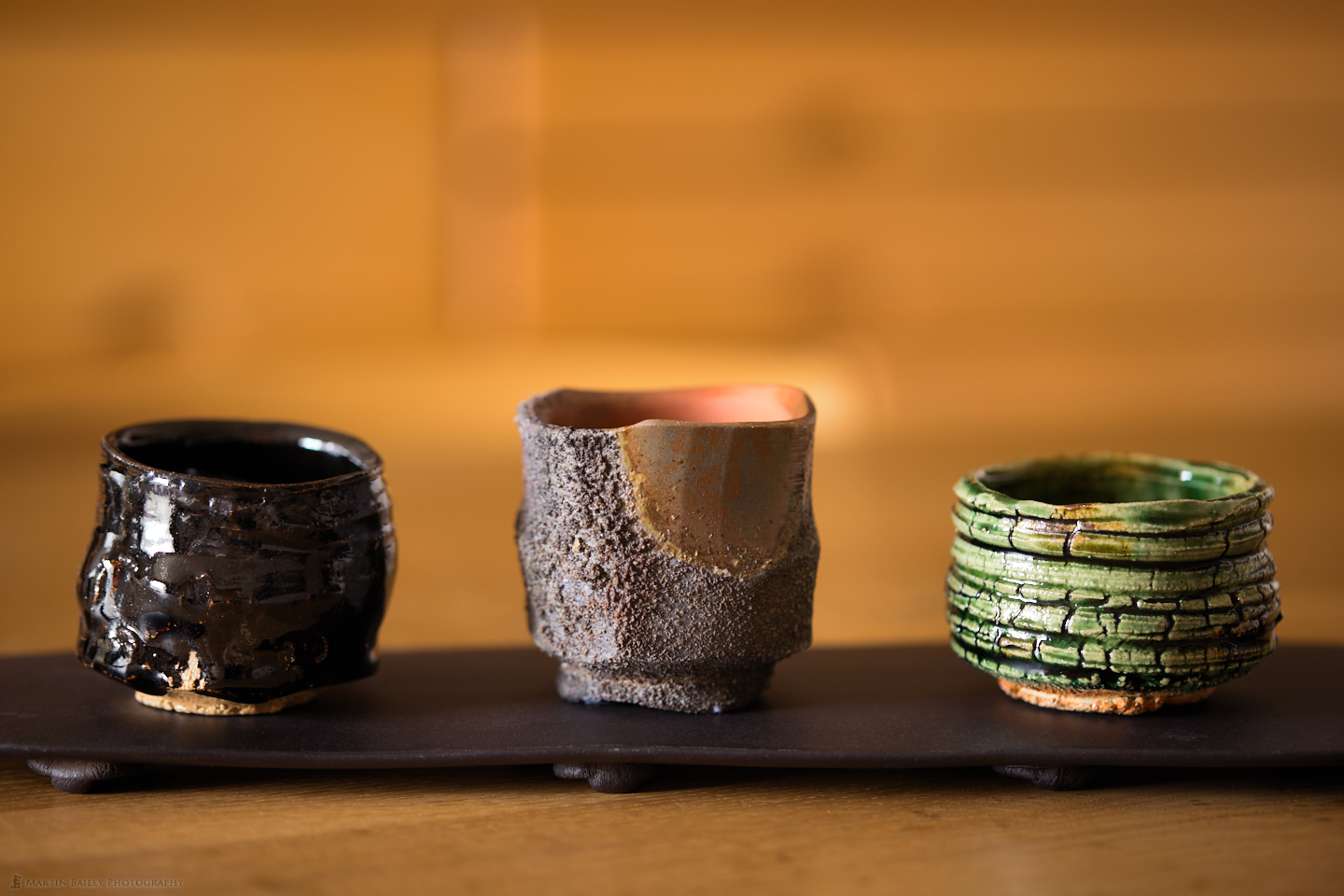
You’ll notice that there is a slightly lighter area in the wood that forms a kind of halo around the top of the center and left cups. That’s actually the back of my chair just visible over the surface of the table. I left it there to provide a little variation, and although it’s very blurred, I think it adds to the domestic situation slightly. This is the only shot in which I included that base from what I think is the “Tokoname” kilns which we bought from the Tokyo Tableware Festival at Tokyo Dome a number of years ago.
After that, I switched between three placemats that I bought from a department store here in Tokyo, purely for photography purposes. We’ve never actually used these when setting the table. Here is the almost black one with the same three cups. I’m afraid we can’t remember where the center Guinomi was made. We bought it at the Tableware Festival too, but the name escapes us. The black cup on the left is Kuro-Oribe. Oribe is a famous group of kilns and the vessels from there are usually the signature green of the Oribe cup on the right. Kuro just means black and added to the name when the Oribe is not green.
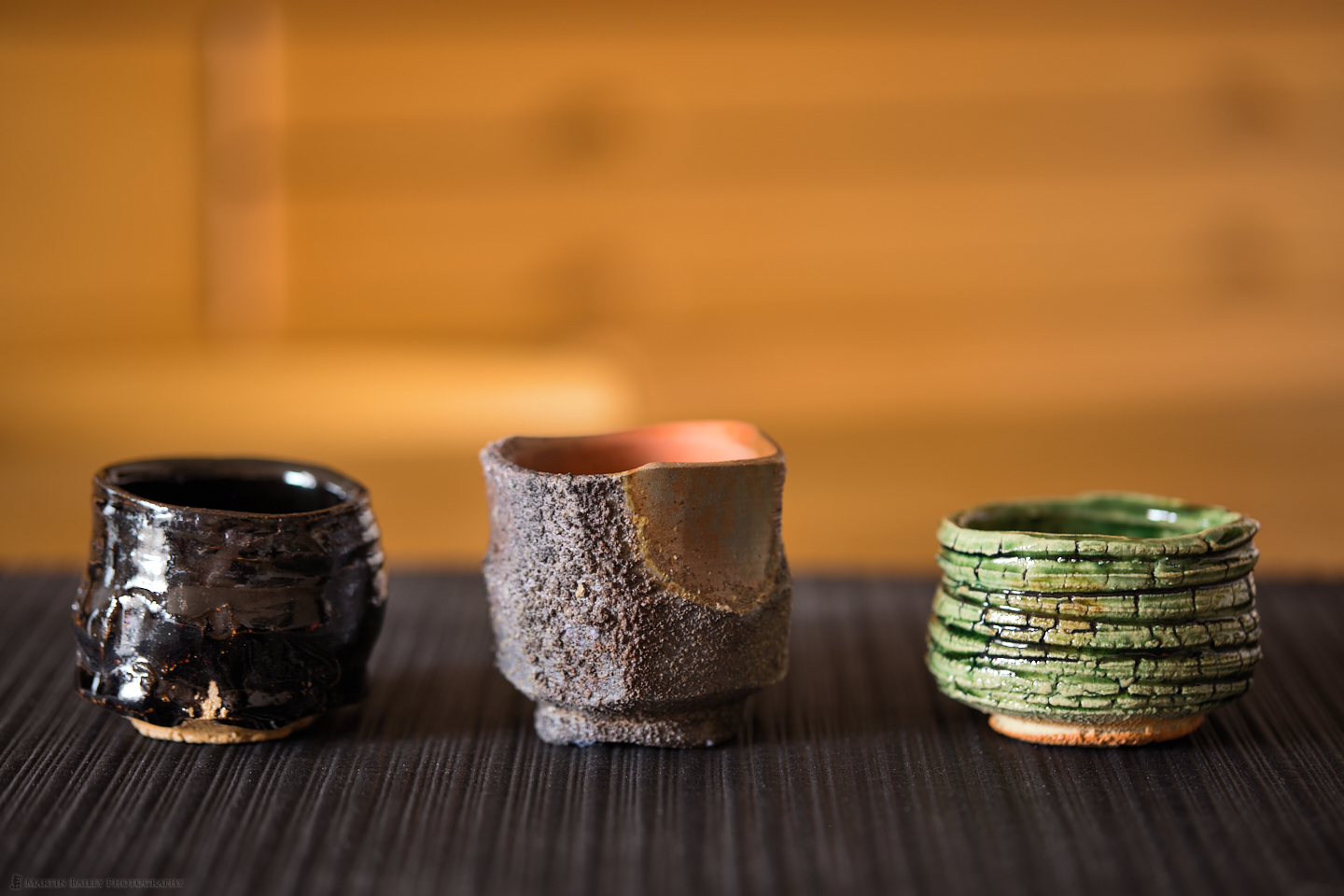
I should also mention the concept of Wabi-Sabi, which is what put me on to the topic of shooting these cups and bowls in the first place. In Japanese aesthetics Wabi-Sabi basically means beauty in imperfection. These cups are intentionally rough, not straight, and as you see, in this case downright gnarly, but that, right there, is what makes them so beautiful. You’ll notice this in pretty much all of the pieces that I’ll share with you today.
I won’t mention the shooting data for all of these images, as you can see that by clicking or tapping on the images and opening them up in the Lightbox, but just to get us started, I was using my 100mm Macro lens at ƒ/2.8 with a 0.8-second shutter speed, so you can tell there was very little light. With a well-chosen shutter speed though, essentially just exposing to the right of the histogram as I always do, it is nice soft light, which I enjoy shooting in. Note too that while using these mats with lines on them I was relatively careful to ensure that they were in line with the lens axis so that the whole thing didn’t look skewed.
This next cup is for drinking Shochu, which is a clear alcohol that comes in various grades from pain-stripper cheap to incredibly expensive. Shochu can be made from just about anything, though wheat and rice based Shochu is common, and I’ve also seen it made with corn, potatoes and many other ingredients. My favorite, and a drink that I easily drink more than Sake is called Imo-jochu. Imo means potato but in this instance it’s actually sweat potato, and creates a type of Shochu that is much more of an acquired taste. When I first tried Imo-jochu around 17 or 18 years ago, the first glass I tried was horrible. Fortunately the alcoholic content kicked in, and the second glass was much better. By the time I’d finished my third glass that evening I was a convert.
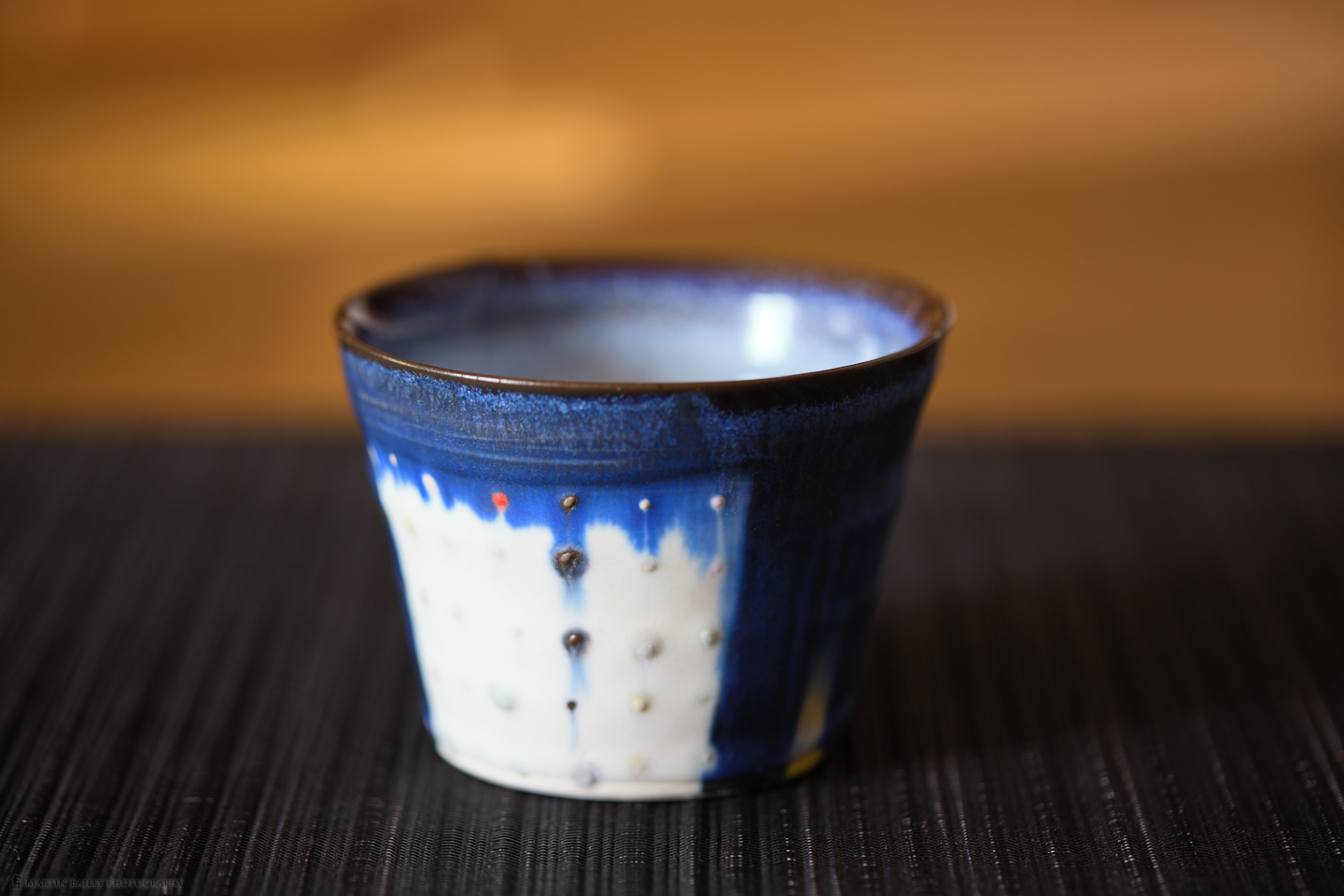
I bought this cup directly from the person that made it at a department store here in Tokyo. I fell in love with this instantly, and although it was a little over $50 I couldn’t prevent myself from buying it. One of the setting points was that single red dot that you see in this photo, but I like the overall design, and when I peered into the cup, I found the white base mesmerizing. I was both surprised and completely not surprised when the person that made it told me that his kiln was Taisetsugama, right by the Taisetsu mountain range in Hokkaido.
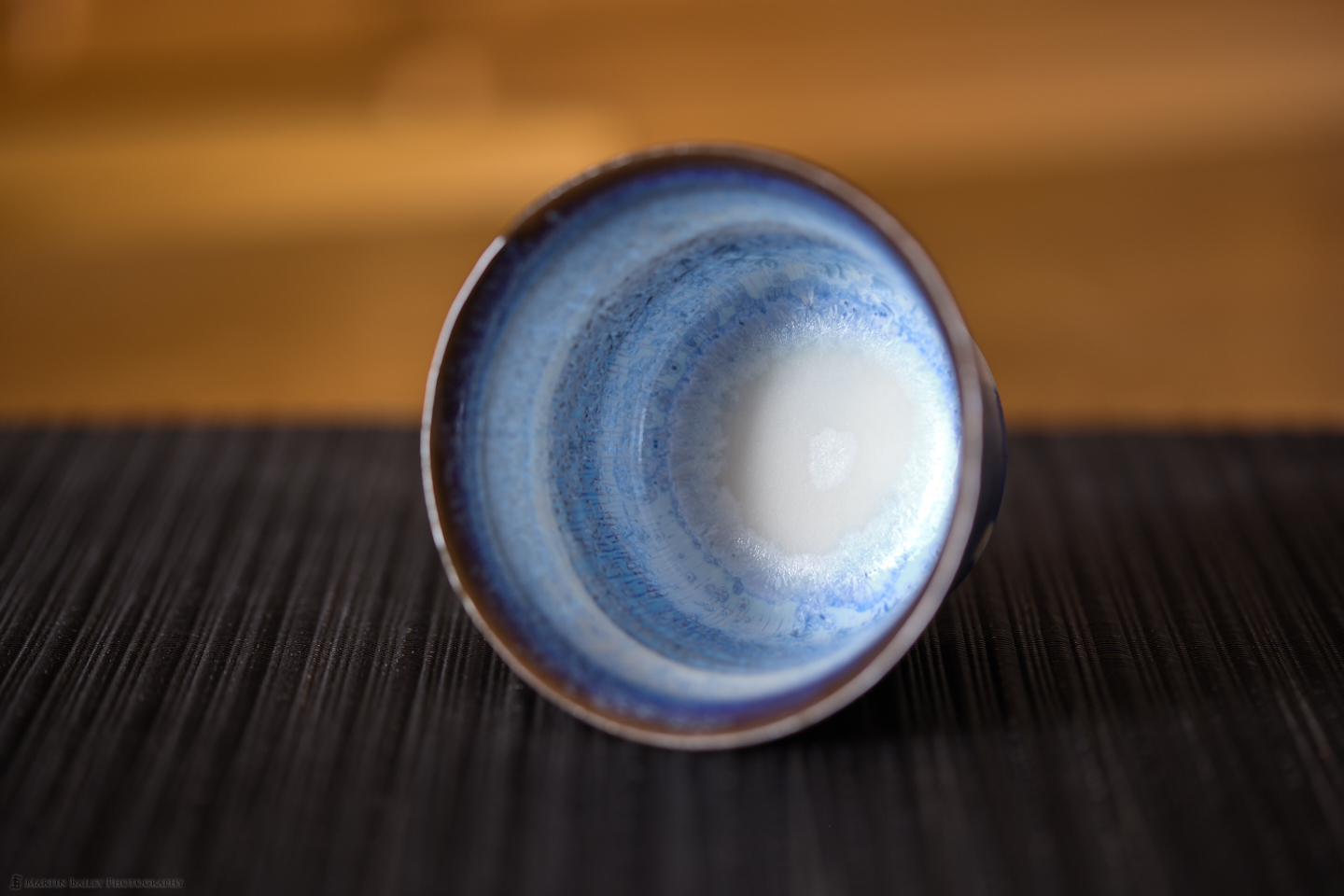
This next cup is made of a section of bamboo, treated with the lacquer also used for lacquerware, but here they’ve left the organic feel of the bamboo, and the lacquer almost has almost a matte feel to it. I use this one more often than not when I want to drink Sake, as in Japanese rice wine, from a larger cup than my Guinomi that we looked at earlier. I generally use the Guinomi when I sit with the bottle so that I can fill it up more often, but when I’m drinking something chilled or maybe relatively cheap sake from a carton, I will just pour it into this larger cup, and then I don’t have to sit with the bottle or carton.
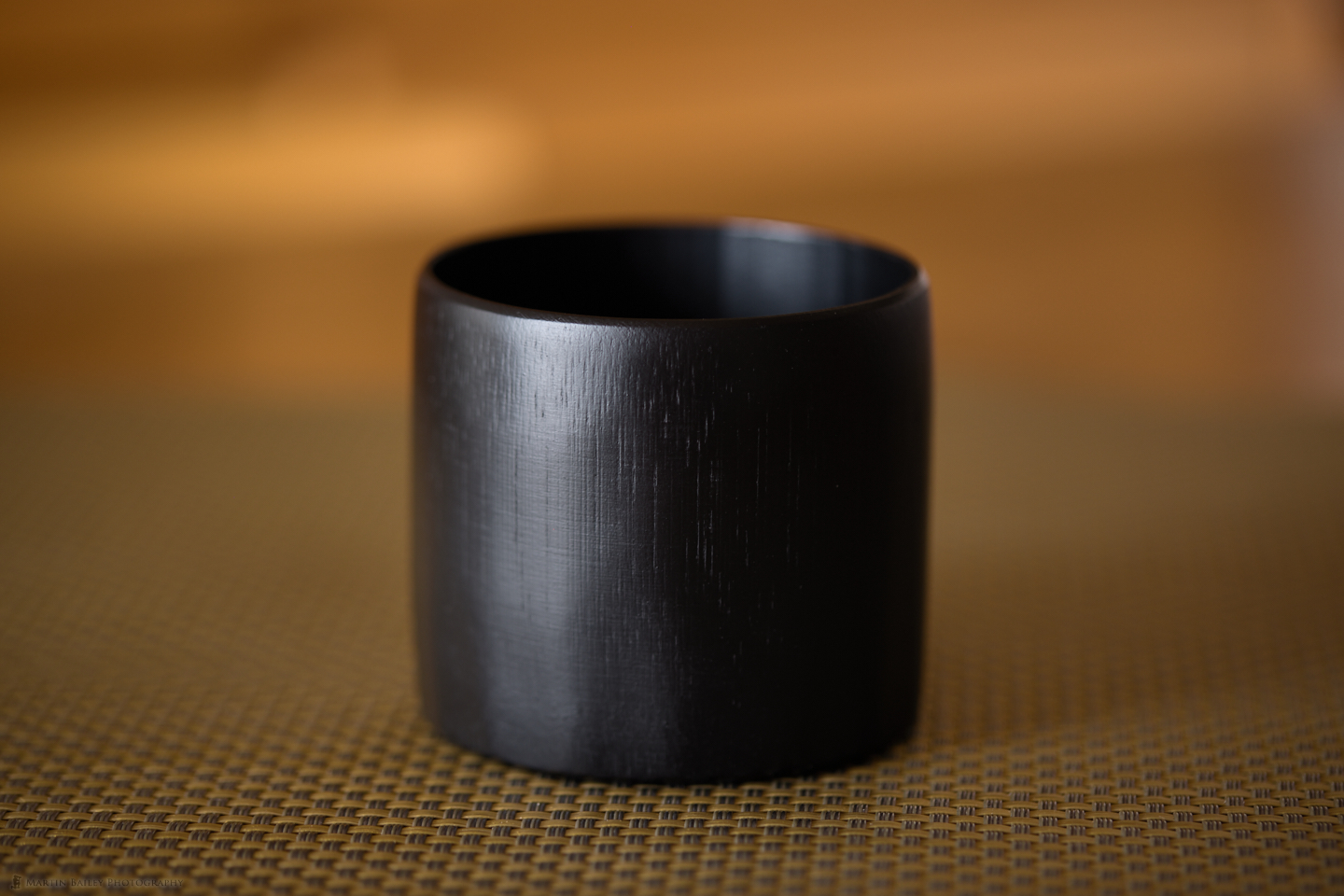
This cup is very light, and you have to wash and dry it after use. You can’t, for example, as we often do with the cups used at the end of the day, just fill this with water and leave it to soak, then wash it in the morning. When I use this cup I have to wash it as soon as I’ve finished using it, then I dry it with a paper towel and put it back into our cabinet. One of things that I fell in love with with this cup is the base, which I included in this photo.

As you can see, the craftsman that makes these simply leaves the natural segments that form inside the bamboo to form the base of the cup. You can generally see where these sections are from the lines seen from the outside, so they must be cutting them at just the right point to make use of this base and leave the top open.
Very long time listeners might recall a commercial shoot that I did around 12 years ago when I drove all the way up to one of the northern-most prefectures of Japan and spent two days photographing a man that farmed trees to scrape lines in their bark and collect the sap, which was then used to make the traditional Japanese lacquerware. The town was called “Joboji” and is famous for high-quality lacquer and lacquerware. While on that job I visited one of the craftsman workshops where the lacquerware is made and spent over $200 on these two lacquerware bowls. Luckily my wife loves these as much as I do, so I got away with the hefty purchase, but these have become one of our household treasures.

I love how there is a little bit of black lacquer showing through in areas in the red bowl, but that deep rich black and the texture of the black bowl is simply beautiful to me. In English when we want to describe very deep black, we might say pitch black, or black and pitch. In Japan, the word for very dark black is “Shikkoku” which literally means this very dark lacquerware black that you see here. I should also note that although the red bowl might be considered slightly Wabi-Sabi, with the black showing through, the black bowl is perfect in every way. To get that dark black the bowl would have been carefully milled, then sanded smooth, then the lacquer applied then allowed to dry, then polished and lacquered again up to 30 times to get it that perfect.
By contrast, these three bowls that you see in this next photograph were bought by my wife and are relatively inexpensive, but also some of our favorite pieces. They’re just fun to use for small items that we put on the table, such as for example, a bowl of sugared black beans that might end up as our dessert after a meal.
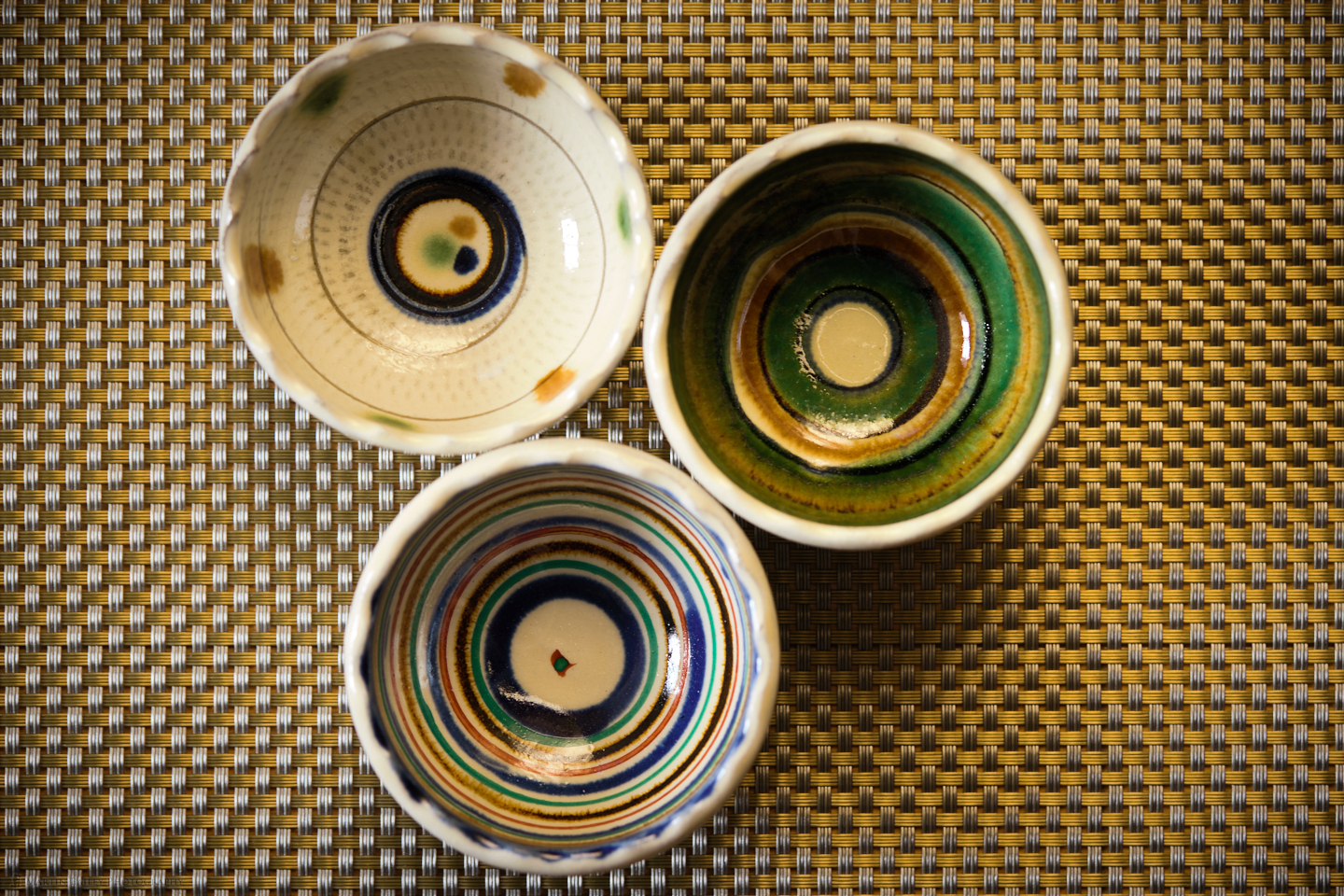
So that I could shoot these from above, I put the placemat on the floor and just pointed my camera down at them. This is one of the shots where I used the gold reflector to the right to bounce a little bit of warm light back in to what would have otherwise been pretty dark shadows.
Here also is the same three bowls but back up on the table, so that you can see their shape from the side, and that they are actually tripods. They have three little feet, which I think is quite cute. Thinking about it, these are from Okinawa, when we visited around ten years ago now to do a workshop. My wife went out with a friend’s wife and picked these up while I was teaching my Pixels to Pigment workshop. A good find that we both enjoy a lot.
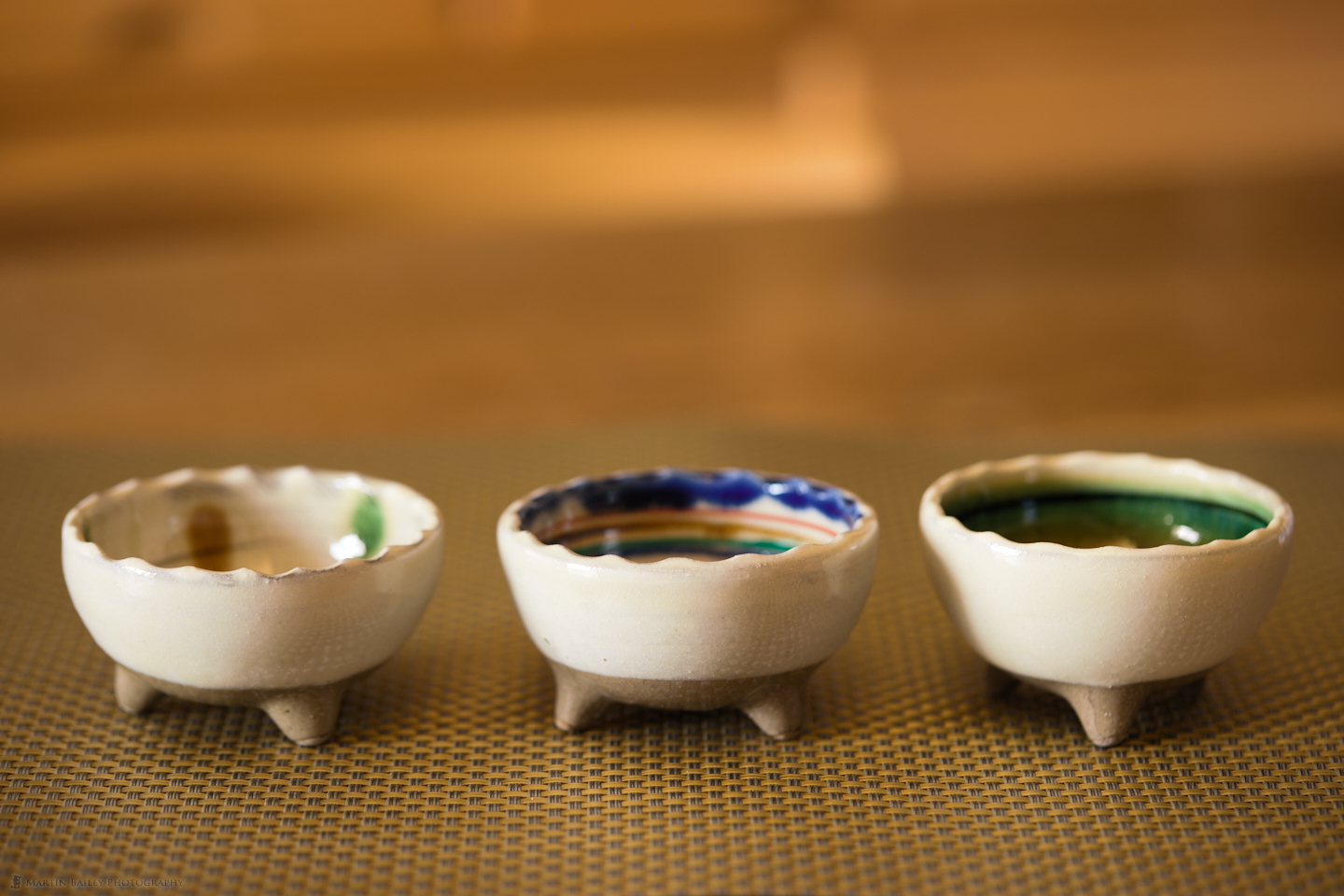
These next two bowls are also lacquerware, from the city of Aizu in Fukushima. These were about half the price as the Joboji bowls, and have a more down-to-earth feel about them. You might not be surprised to hear that we have actually never eaten from the Joboji bowls, but we use these two pretty regularly. After cooking most of our meals for the last 25 years my wife is frankly tired of cooking. She also doesn’t really like me to get into the kitchen, so I don’t get permission to cook for us very often either, which means that we sometimes rely on take-outs and convenience store bentos, but it’s a good way to keep stress levels down. When she does cook though, she always does a really good job of selecting the best bowls to serve each dish in, and it’s always a pleasure to see what she’s selected.
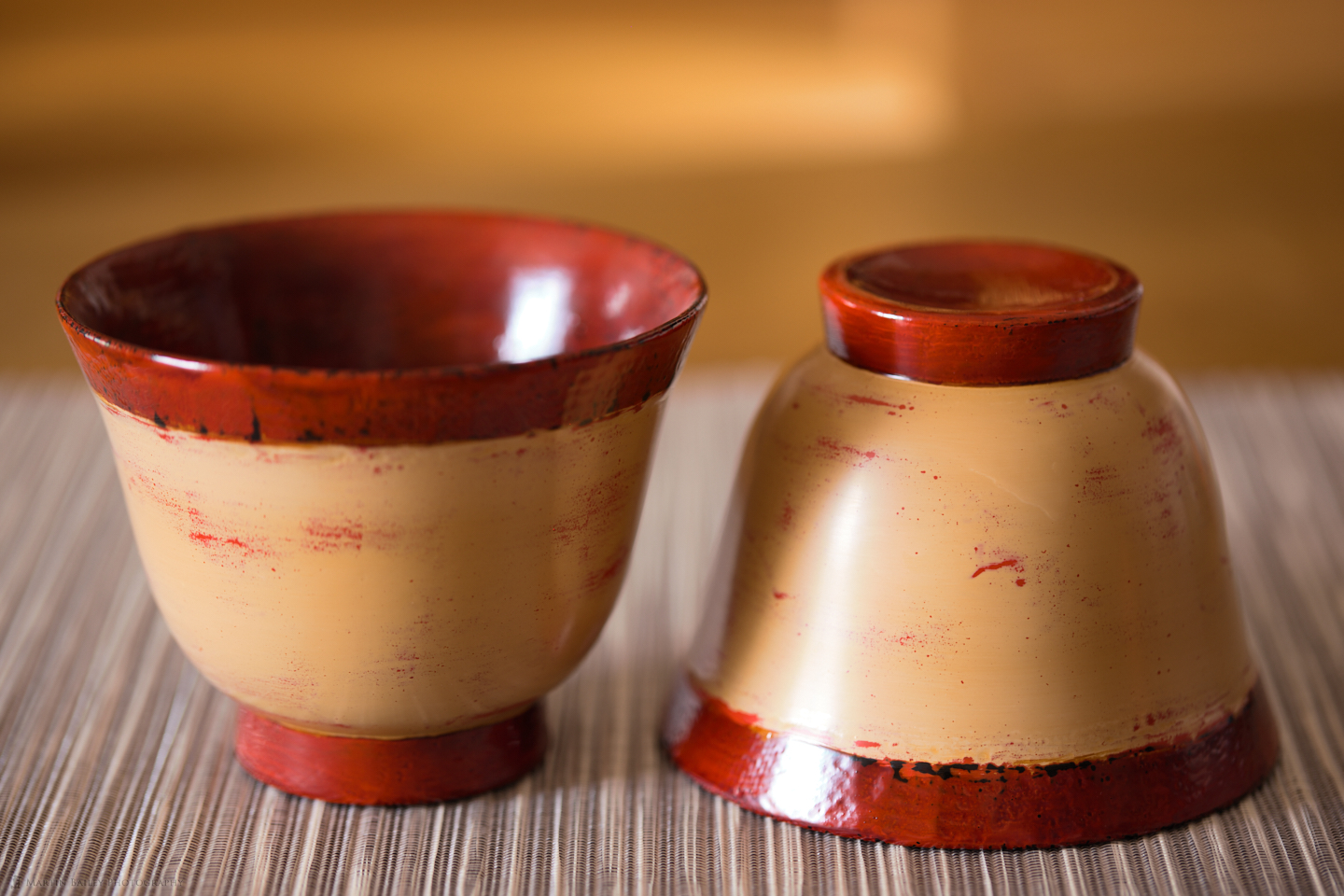
The three little bowls that you see in this next image are inexpensive again, but we really like the simple design, and how the smaller bowls fit away nicely, nested inside the larger ones. These are often used to serve some “Shichimi” or seven spices to put into noodles, another favorite dish.

You’ll notice that the painted lines aren’t perfect, but again, even in these regular kitchen bowls, we get a sense of the Japanese Wabi-Sabi that I mentioned earlier. It’s that beauty in imperfection that we enjoy so much.
I also shot my three Guinomi individually, but as I’ve already talked about these, I’ll just drop them in here in a gallery for you to look at.
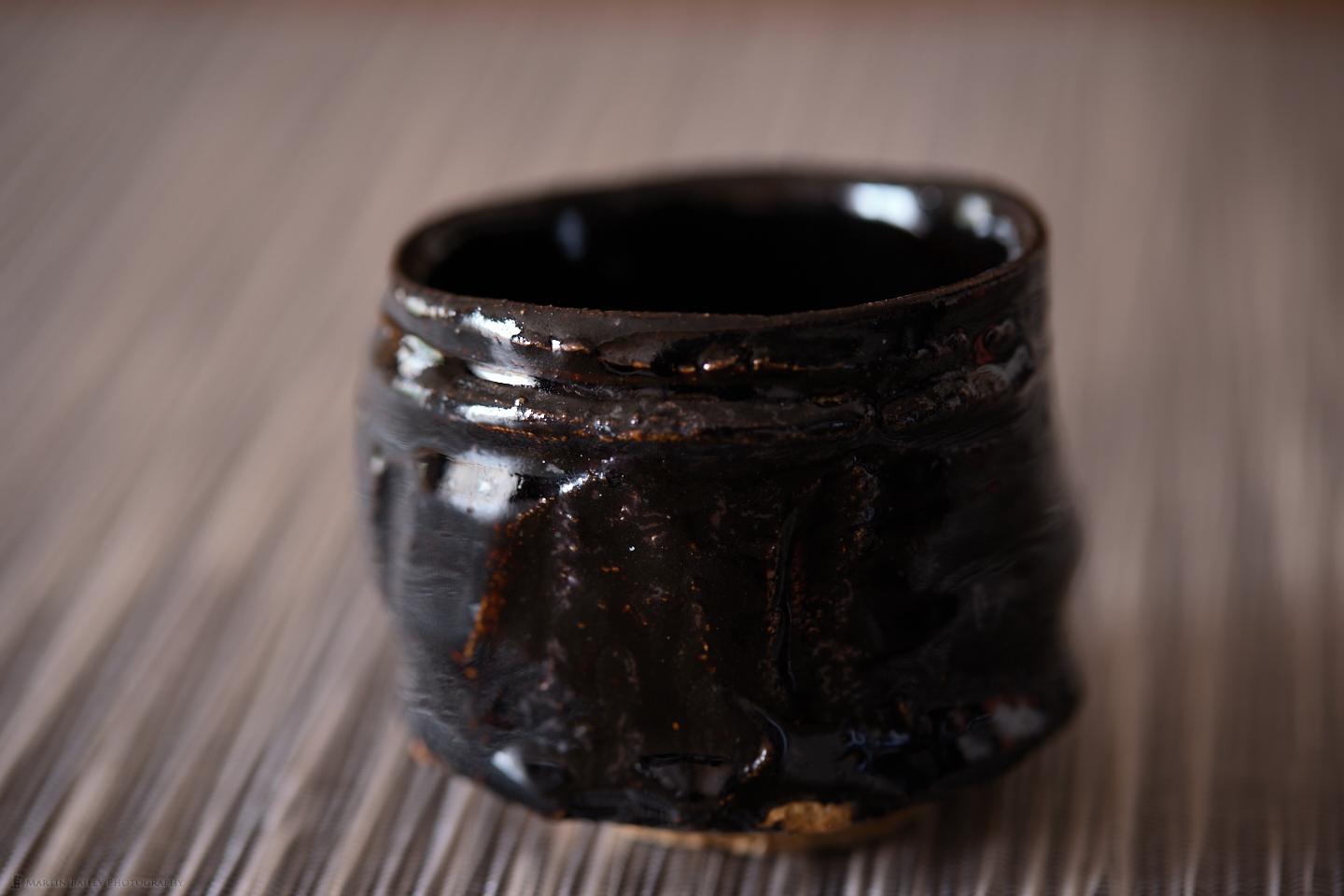
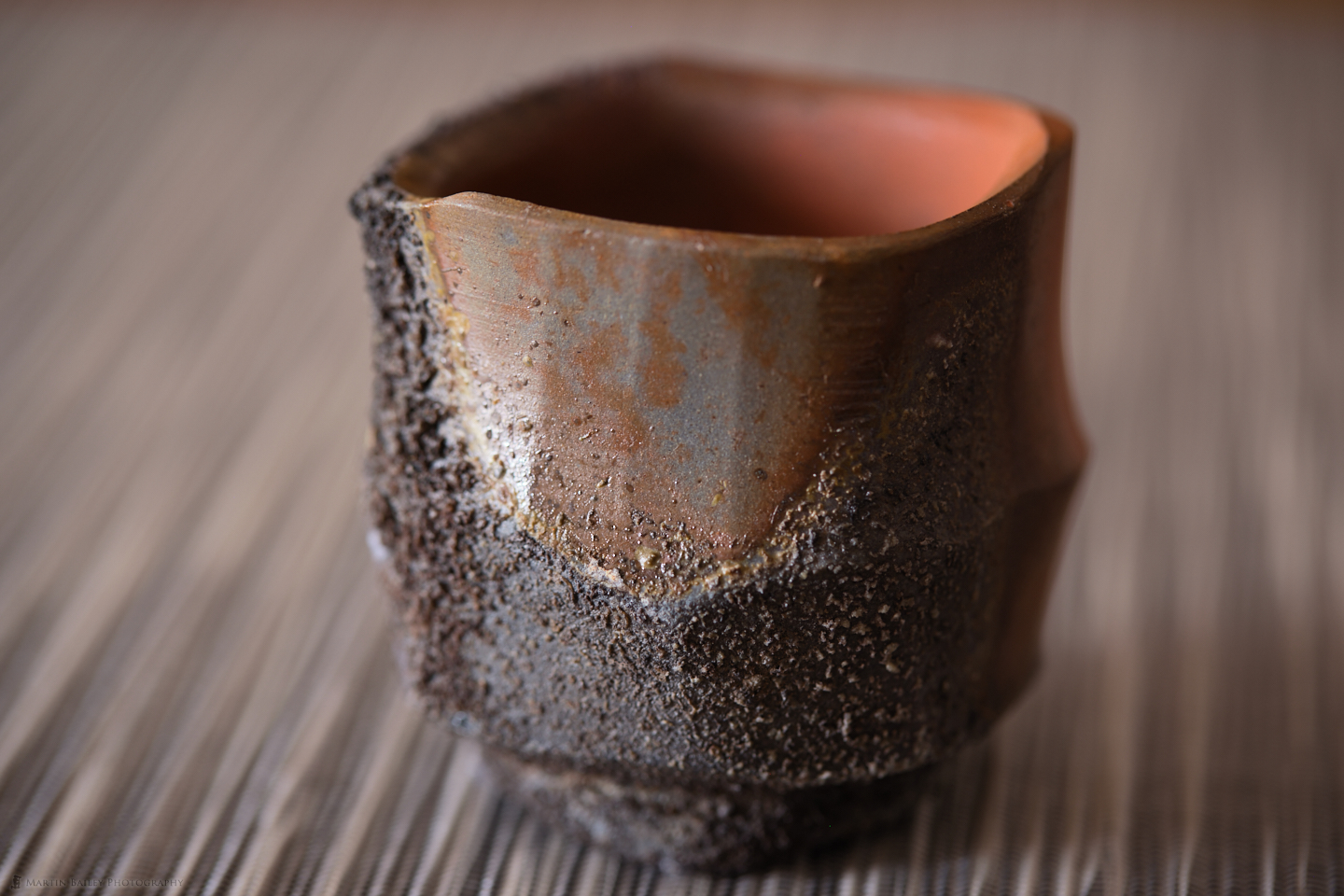
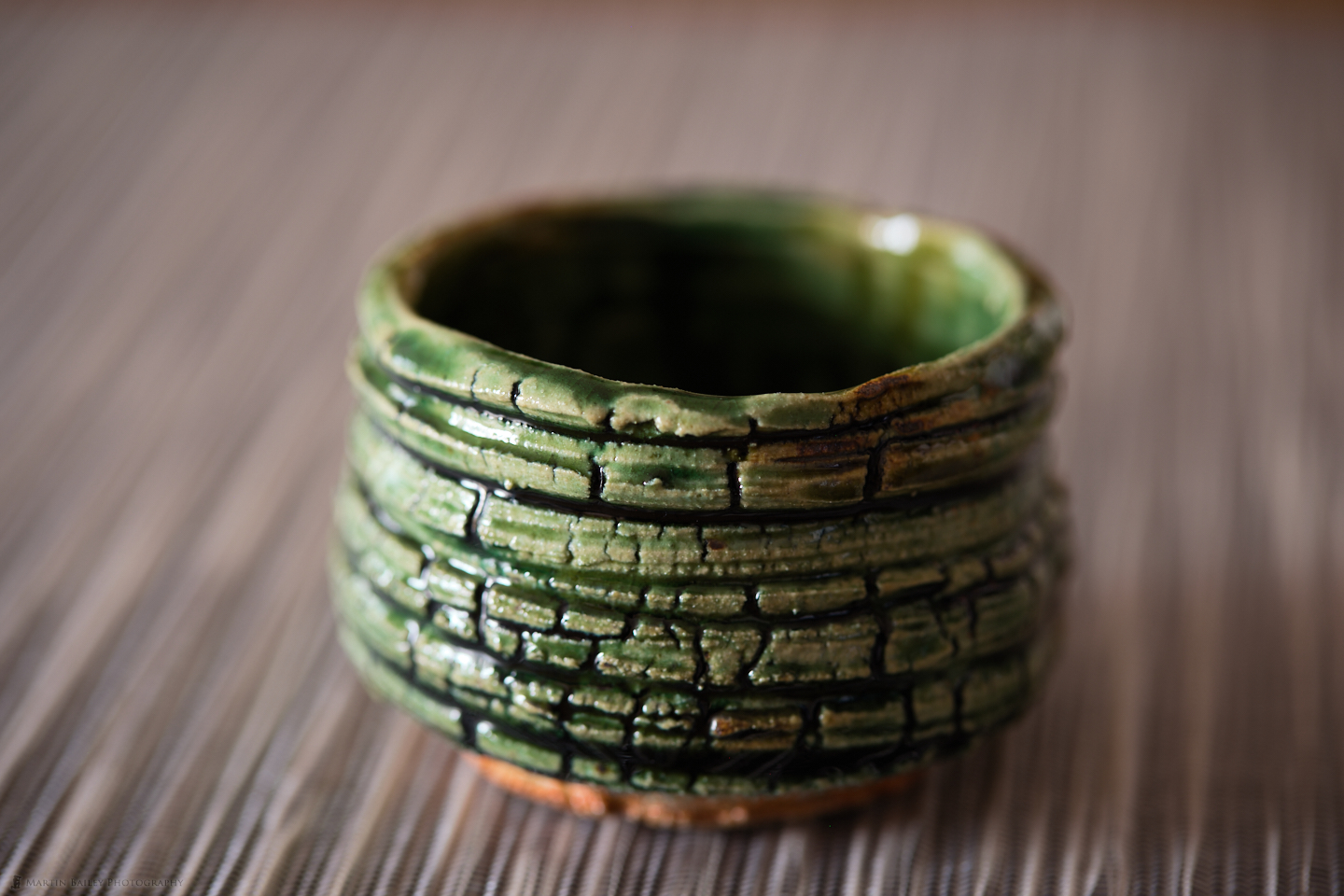
To finish with, here are two Soba-Choko, again, from the Oribe kiln, hence that signature green color. You’ll see that they’ve broken up the monotony a little with those amoeba-like forms in the design, which we found quite appealing. The word Soba means buckwheat noodles, and Choko is the cup, the same as “Ochoko” which is just adding the honorific “O” to the word for a small cup. These are what you put the dip for the noodles into, often with some thinly sliced onions and broken up nori, the dried seaweed that you often see wrapped around rice balls, or Onigiri.
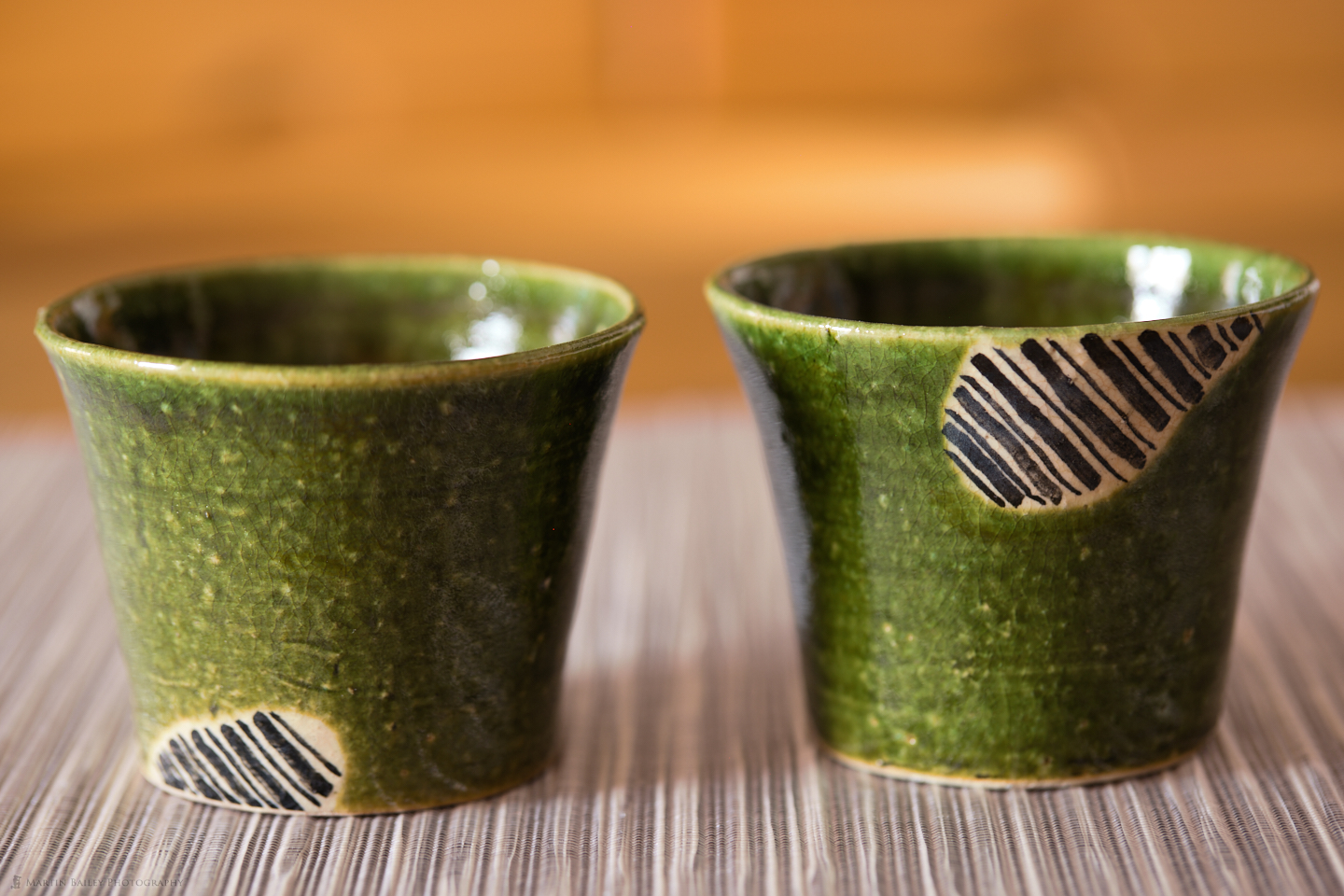
OK, so we’ll wrap it up there. We have heaps more crockery, and we only concentrated on Japanese vessels. If I start on our western-style crockery I’d need another few episodes, but it’s not as interesting as this Japanese stuff, which I hope you enjoyed seeing. I think I’ve captured the warmth of our home in these images to a degree too, so I hope that comes across. I’m incredibly thankful for the life we have, and my wife makes it all so very special. I’m lucky to have her in my life to make it richer and so much more fun!
Show Notes
Audio
Subscribe in iTunes to get Podcasts delivered automatically to your computer.
Download this Podcast as an MP3 with Chapters.
Visit this page for help on how to view the images in MP3 files.


Martin, I very much enjoyed this post. Your photography brilliantly emphasizes the beauty of your family’s “humble” bowl collection. Thank you for teaching me about Wabi Sabi.
Hi Joe!
It’s great to hear from you. Thanks for stopping by.
I’m pleased you enjoyed this post too.
Regards,
Martin.
Hi Martin, That was worth the wait. What a feast of colour and texture!
Thanks, Ulana! I’m really pleased you enjoyed this.
All the best!
Martin.
Lovely. As a fan of Japanese ceramics (and cuisine) as well as photography, I enjoyed this post. Although I have to say that your expensive lacquer ware bowls are particularly stunning (though neither ceramic or imperfect)!
Hi Mary,
Thanks for the comment! I couldn’t agree more. Those two bowls are perfect in every way. A tribute to Japanese craftsmanship. Both nicely done wabi-sabi-ness, and this level of perfection, are pretty hard to achieve.
Regards,
Martin.
Loved this post, Martin. I lived in Japan for a short while in 1993 and have travelled there many times since and love my collection of lacquerware, bowls, cups etc. Thanks for sharing!
Thanks, Sue! That’s great to hear.
I love these Martin. If you haven’t come across it, I’m guessing you’d enjoy Andrew Juniper’s book ‘Wabi Sabi: The Japanese Art of Impermanence’.
Thanks, Jay! I’ve not heard of that book. I’ll have to keep my eye out for a copy. Thanks for the heads-up!
Beautiful, I enjoyed hearing the specific use for each one.
Good to hear Luc! Thanks for stopping by.